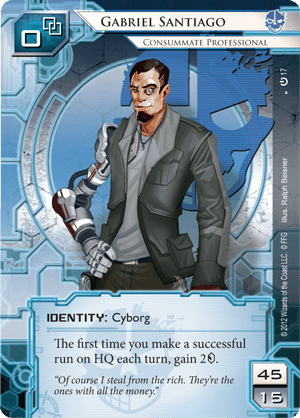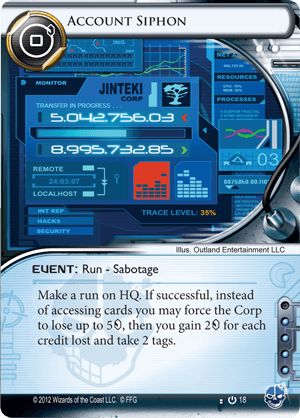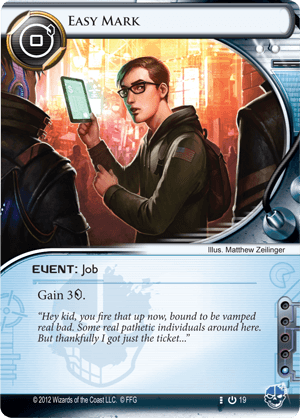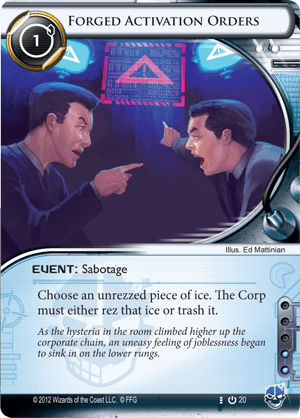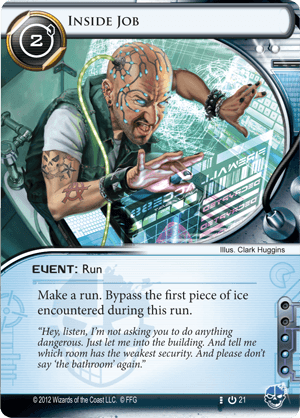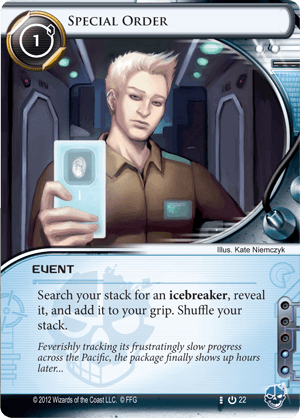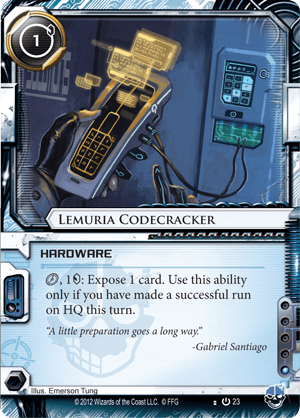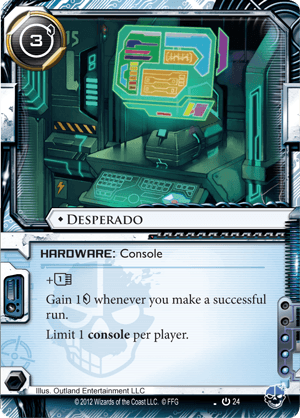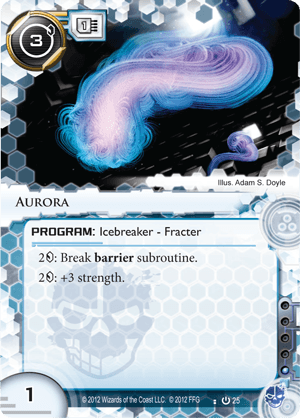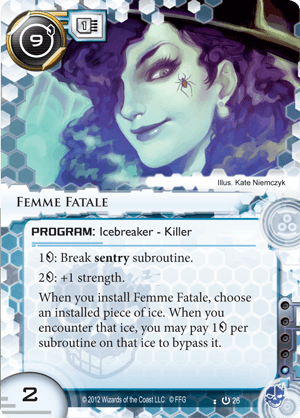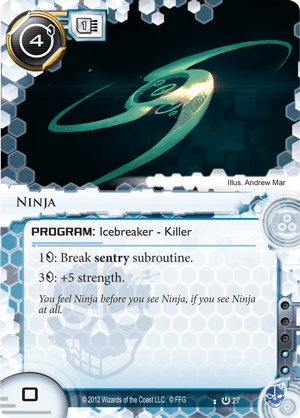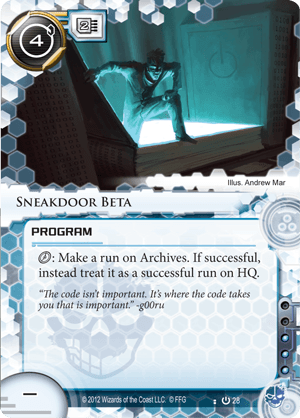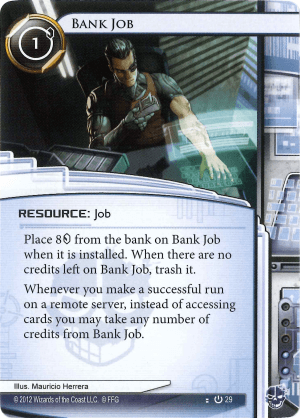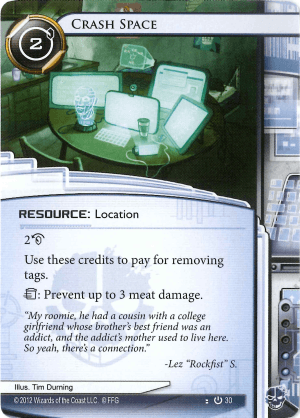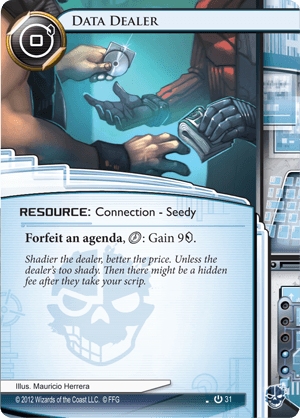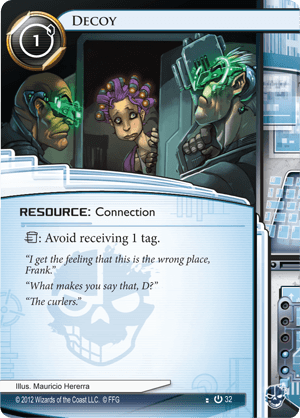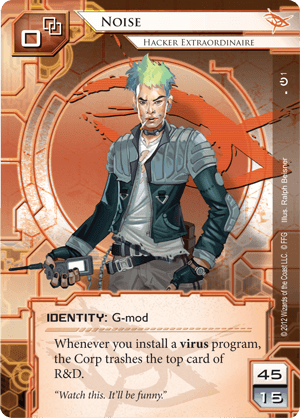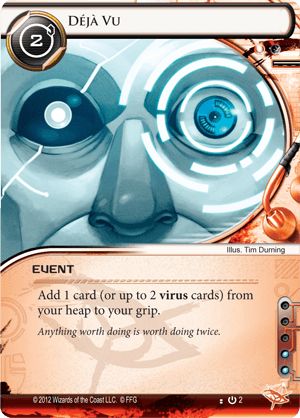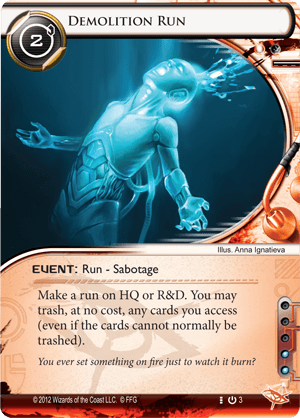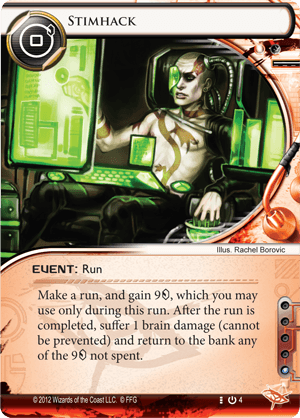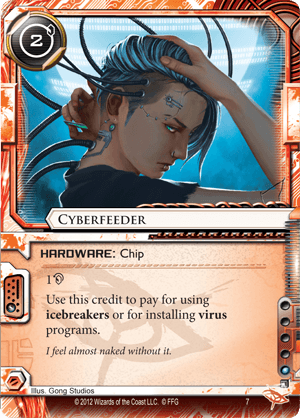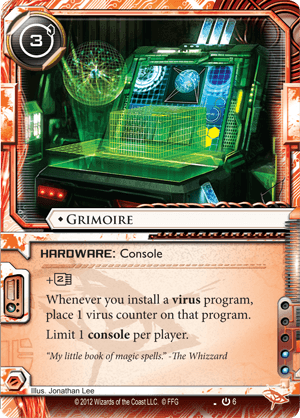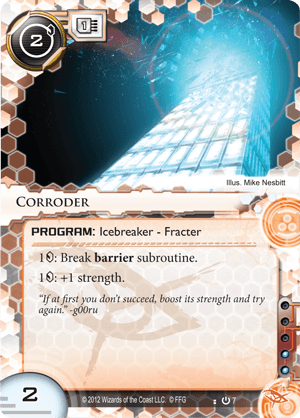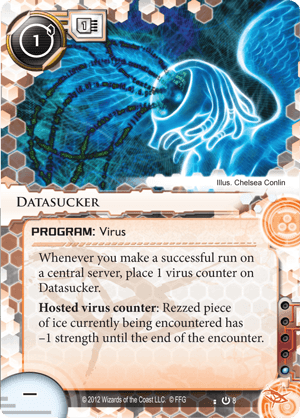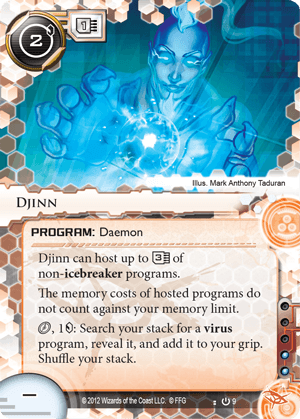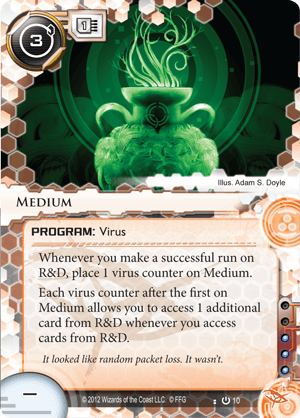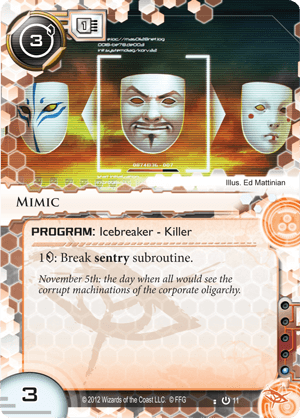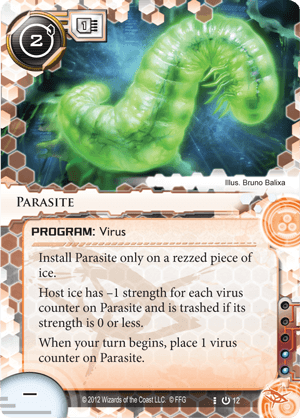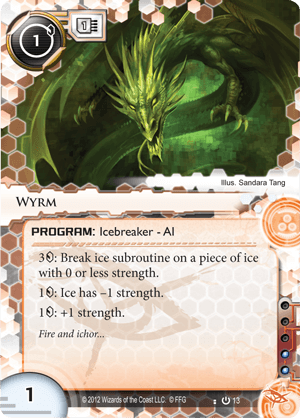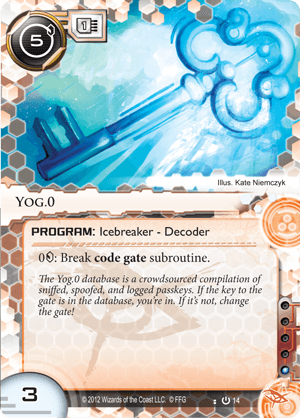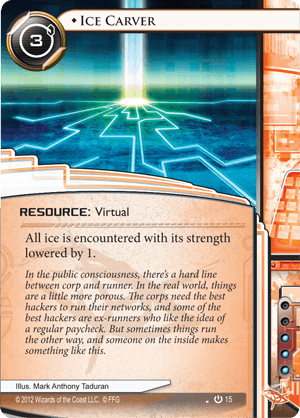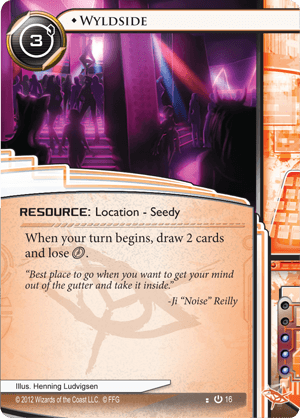I believe it must have been this past summer when I first started experimenting with an idea for a new form of the Butchershop deck. Granted, Butchershop may have been in decline at that point. After all, I think that was around the time when the 2015 World Championship decks were released, bringing Data Leak Reversal Paparazzi Wireless Net Pavillion Fall Guy to the masses. Still, I went on tinkering with the idea. And I was still able to win a few games with it. So I present to you my own spin on Butchershop:
Michael Bay Presents: Explosions! - 49 cards
Identity: Harishchandra Entertainment - Where You're the Star
Agendas (21 points)
Executive Retreat - 3
Restructured Datapool - 3
TGTBT - 3
Ice
Data Raven - 3
Hunter - 2
Pop-up Window - 3
Tollbooth - 3
Wall of Static - 1
Wraparound - 3
Assets
Jackson Howard - 3
Lily Lockwell - 3
PAD Campaign - 3
Operations
Archived Memories - 1 (2 influence)
Hedge Fund - 3
Midseason Replacements - 2
Scorched Earth - 3 (12 influence)
SEA Source - 1
Sweeps Week - 3
Traffic Accident - 3 (3 influence)
Being a Butchershop variant, the main idea is to try and tax the runner so you can set up for a kill. However, I don't think this arrangement does it very well. I've gone with Harishchandra over Near-Earth Hub as I find I don't use the ability of NEH frequently enough to benefit from it, while knowing what the Runner is holding could be of great use. That is, when I remember to tell the runner.
Agendas are a bit interesting. TGTBT is there primarily to be used as bait. You want the runner to hit this so you can folllow up with Midseason for even more tags. Restructured could let you place large amounts of tags on the runner. Executive Retreat is there mostly as filler, as I couldn't bring in Global Food Initiative due to the influence limits, and the deck isn't really set up for that. Though, it might be a good idea to replace Executive with GFI and the Restructured with Explode-a-palooza. The second one would certainly be thematic. Maybe then replace TGTBT with Project Beale.
Ice is a mix of permeable and somewhat taxing. It's not supposed to be about always keeping the runner out so much as it is letting them in at the right time, in theory. Data Raven forces a tag, letting you see their hand, and maybe can let you place a tag at any time. Hunter could land an early tag as well, plus it is cheap to rez. Pop-up Window taxes the runner slightly, and makes some money for you. Tollbooth should be taxing as well, although with Hunting Grounds becoming more popular, it may not be as taxing as it once was. Wall of Static and Wraparound offer some cheap ETR ice that should still be a little taxing as the game goes in.
Assets are focused mostly on getting to the cards you need. Jackson for straight up card draw and some recursion. Lily Lockwell is an interesting choice. She gives you three cards on rez, so ideally you want to bring her online when you are about ready to make the kill. She can also be used to put an operation of your choice on top of the deck at the cost of a tag, so you could make decent use of the tags piled up on the runner. PAD Campaign provides some drip economy.
Operations are the main way you will win. Scorched Earth and Traffic Accident are your kill cards. You'll ideally want at least one in your hand to make the kill so you can draw into another. Midseason is how you'll get enough tags on the runner to make the kill. SEA Source can land a tag to set up for a double Scorched. Sweeps Week and Hedge Fund provide some burst economy. Finally, Archived Memories sort of acts as a copy of any operation in your discard pile, or lets you pull off a kill with one Scorched, as you can use Archived Memories to get it back on the same turn you played it.
Now the downside. The deck feels very vulnerable to Shaper. It's easiest for them to defeat traces thanks to their easy access to lots of link strength, plus they have Film Critic in faction, which dodges both TGTBT and Midseason Replacments. Criminal will also likely present problems, as Account Siphon can leave you without the money needed to make the kill unless you are lucky enough to have all three copies of Traffic Accident at once, and they don't bother removing the tags. Finally, there's always the possibility that Plascrete Carapace will show up, which will make it much harder to make the kill. It is possible to score out, but if the runner has had the time to set up, it's not likely you'll be able to do so.
Out of the ten games I recorded while playing this deck, I won 5 and lost 5, giving this deck a win rate of 50%, which is not great for a Butchershop variant. As such, I put aside the deck for a while. But that's the thing about movies - there's typically a sequel in the works.
Oh, and the deck takes its name from a sketch in an episode of Robot Chicken. In the sketch, the characters are watching trailers in a movie theater, and one of the trailers is for a movie by Michael Bay which is nothing but explosions. You can view the clip here: https://youtu.be/v7ssUivM-eM
Until next time, keep circulating the tapes.
Thursday, December 22, 2016
Thursday, December 15, 2016
The Yellow King 2017 Season Store Championship
December marks the start of the 2017 Store Championship season, even though it is still 2016. Still, this past weekend was the first one I was able to attend. Here's what I was able to come up with this time.
Adam's Source - 49 cards
Identity: Adam - Compulsive Hacker
Programs
Corroder - 2 (4 influence)
Datasucker - 2 (2 influence)
Gordian Blade - 2 (6 influence)
Multithreader - 3
Ninja - 2 (4 influence)
Hardware
Brain Chip - 3
Resources
Always Be Running - 1
Armitage Codebusting - 3
Daily Casts - 3
Dr. Lovegood - 3
Find the Truth - 1
Neutralize All Threats - 1
Safety First - 1
Scrubber - 3 (3 influence)
The Source - 3 (6 influence)
Events
"Freedom Through Equality" - 3
Dirty Laundry - 3
Independent Thinking - 3
Sure Gamble - 3
Find the Truth is a big boon to Adam, as it means you are no longer forced to make a run at the start of every turn due to Always Be Running. As such, my starting directives were always Find the Truth, Safety First, and Neutralize All Threats. Basically, you want enough time to set up your basic rig, which The Source can help give you by delaying the corporation from scoring out too fast. Once you have your breakers and a Multithreader or a Datasucker, you can start the process of snowballing. The Source is especially good for Adam, as you can use Dr. Lovegood to shut it off on your turn, meaning you don't have to pay the extra cost to steal agendas, and it doesn't trash itself if you do steal one. Economy is a bit mixed, but fairly decent. Independent Thinking gives you some extra draw, and there's a backup of each directive in case you trash one that you want back.
Your Brain on Drugs - 44 cards
Identity: Cybernetics Division - Humanity Upgraded
Agendas (18 points)
Accelerated Beta Test - 3
Global Food Initiative - 3 (3 influence)
Self-Destruct Chips - 3
Ice
Gyri Labyrinth - 3
Heimdall 2.0 - 1
Janus 1.0 - 1
Mother Goddess - 1
NEXT Bronze - 3
NEXT Gold - 3
NEXT Silver - 3
Wotan - 1
Assets
Cerebral Overwriter - 3
Jackson Howard - 3 (3 influence)
PAD Campaign - 3
Upgrades
Cyberdex Virus Suite - 1
Operations
Biotic Labor - 3
Hedge Fund - 3
Lateral Growth - 3
Rumor was that a bunch of players from Denver were coming down with Jinteki net damage decks, so I figured why not try running a brain damage kill deck. Granted, I probably could have done a better job with it. I clearly didn't use all the influence, mostly because I had no idea what else I could have brought in to improve the deck. And yes, there's no Enforced Curfew in the deck because I didn't own a copy of Martial Law when I pulled this deck together. Otherwise, it's kind of a fairly standard fast advance deck. Also, I put in one of each Heimdall 2.0, Janus 1.0 and Wotan because I was hoping that with this much ice in this small of a deck, I might have been able to hit one with Accelerated Beta Test.
Time to see how well it worked. On to the rounds.
Round 1: vs. Adam
Adam vs. Engineering the Future: 9 - 6 W
Cybernetics Division vs. Noise: 2 - 1 W (flatline)
Not exactly sure if it's ironic that I ended up playing against a person named Adam with my Adam deck. Still, it was an interesting first game. I ended up taking some brain damage early on due to face checking a Viktor 1.0 and later a Heimdall 1.0 on the last click before my Corroder was up. Still, I was able to use Safety First to draw into a Brain Chip, and then offset the brain damage by snagging a Mandatory Upgrades. That started the ball rolling. I was able to pull two more Mandatory Upgrades, but he was able to score out 3 Accelerated Beta Tests, so it was close. However, I pulled a Priority Requisition out of his hand to win. Corp game was also interesting. I used Biotic Labor in order to score out an ABT on turn two, getting a NEXT SILVER and giving up a Self-Destruct Chip as a result. Still, I was able to lure him into a twice advanced Cerebral Overwriter, and to top it off, he used Stimhack to get into the server, leaving him with 2 cards in hand. So he took the 2 brain damage from Overwriter, and then died to the damage from Stimhack. Not too bad for the first round.
Round 2: vs. Rick
Adam vs. New Angeles Sol: 2 - 7 L
Cybernetics Division vs. Ele "Smoke" Scovak: 2 - 7 L
Playing against Rick is always quite the experience. I was able to snag a Global Food Initiative and 15 Minutes early on. However, after that he was able to set up his defenses on HQ & R&D. Apparently, there was a point where he was holding onto three agendas in hand, and I just kept missing them when I hit HQ, even with Neutralize All Threats in play. It didn't help that sometimes I forgot to use the positive effects of Find the Truth and Safety First a few times. At any rate, he was able to score out after that. Second game, I couldn't get a good setup as the corp. I ended up dumping high cost ice into Archives and used Jackson before scoring an ABT to shuffle them back into the deck. I was able to get a NEXT Bronze and a Gyri Labyrinth out of that, but it wasn't enough as he was able to get set up and locked down my R&D after that. Still, speaking with Rick afterwards has given me an idea on how to improve the deck. Perhaps a later article will go over that new design.
Round 3: vs. Scott
Adam vs. Architects of Tomorrow: 7 - 0 W
Cybernetics Division vs. Valencia Estevez: 3 - 2 W (flatline)
I'll admit, losing to Rick put me slightly on tilt. It didn't help either that I couldn't quite finish my lunch between rounds 2 and 3, so I wasn't in the greatest mood going into this match. Still, it turned out better than I thought. I was able to snag an ABT off of R&D early on thanks to seeing it with Find the Truth. I then snagged a GFI and played out a Brain Chip. I played Freedom Through Equality and then pulled another GFI out of his hand, which apparently was flooded with agendas, despite his earlier use of Jackson Howard. Second game was pretty bad for him as well. I ended up losing an ABT on turn one, but I think that set my strategy. I was able to lure him into a twice advanced Cerbral Overwriter, which he used a Blackmail on to get to. I snuck out a GFI thanks to two Biotic Labors. Later on, I overwrote a Cerebral Overwrite to lure him into a third Cerebral Overwriter, which he Blackmailed into again. I scored out a Self-Destruct Chips then, putting him onto a one turn time limit, which he was not able to win the game in.
I was able to finish up my lunch after that, and went into round 4 a bit more refreshed.
Round 4: vs. Matt
Cybernetics Division vs. Valencia Esteves: 4 - 7 L
Adam vs. Cerebral Imaging: 7 - 0 W
I was able to get fairly lucky with an early ABT, which pulled out all 3 copies of NEXT Silver, which I used to place one on each of the central servers. That helped protect against Blackmail and DDoS. Still, I gave up too many agendas and credits to Blackmail and Account Siphon. What didn't really help me was him using Rebirth to change into Omar Keung and getting out Obelus, making my kill condition impossible. He then got out a Medium and dug into R&D, taking the last agenda by sneaking into Archives and making it an R&D run. Second game, I was able to build up and snagged an ABT while Freedom was out. I took another ABT off of R&D and was able to snag a GFI out of his massive hand.
So I ended Swiss rounds with a 5-3 record. Unfortunately, that wasn't good enough to make the top 4 and I placed 7th out of 18 players. Still, that was much better than I was expecting to do. I think this Adam build is viable and the Cybernetics Division might do much better once I implement the changes I have in mind. Not sure if I'll be taking them to later store championships, as I think I'd like to test other ideas. Well, if I can come up with any better ideas.
So until next time, try not to fry your brain with stims.
Adam's Source - 49 cards
Identity: Adam - Compulsive Hacker
Programs
Corroder - 2 (4 influence)
Datasucker - 2 (2 influence)
Gordian Blade - 2 (6 influence)
Multithreader - 3
Ninja - 2 (4 influence)
Hardware
Brain Chip - 3
Resources
Always Be Running - 1
Armitage Codebusting - 3
Daily Casts - 3
Dr. Lovegood - 3
Find the Truth - 1
Neutralize All Threats - 1
Safety First - 1
Scrubber - 3 (3 influence)
The Source - 3 (6 influence)
Events
"Freedom Through Equality" - 3
Dirty Laundry - 3
Independent Thinking - 3
Sure Gamble - 3
Find the Truth is a big boon to Adam, as it means you are no longer forced to make a run at the start of every turn due to Always Be Running. As such, my starting directives were always Find the Truth, Safety First, and Neutralize All Threats. Basically, you want enough time to set up your basic rig, which The Source can help give you by delaying the corporation from scoring out too fast. Once you have your breakers and a Multithreader or a Datasucker, you can start the process of snowballing. The Source is especially good for Adam, as you can use Dr. Lovegood to shut it off on your turn, meaning you don't have to pay the extra cost to steal agendas, and it doesn't trash itself if you do steal one. Economy is a bit mixed, but fairly decent. Independent Thinking gives you some extra draw, and there's a backup of each directive in case you trash one that you want back.
Your Brain on Drugs - 44 cards
Identity: Cybernetics Division - Humanity Upgraded
Agendas (18 points)
Accelerated Beta Test - 3
Global Food Initiative - 3 (3 influence)
Self-Destruct Chips - 3
Ice
Gyri Labyrinth - 3
Heimdall 2.0 - 1
Janus 1.0 - 1
Mother Goddess - 1
NEXT Bronze - 3
NEXT Gold - 3
NEXT Silver - 3
Wotan - 1
Assets
Cerebral Overwriter - 3
Jackson Howard - 3 (3 influence)
PAD Campaign - 3
Upgrades
Cyberdex Virus Suite - 1
Operations
Biotic Labor - 3
Hedge Fund - 3
Lateral Growth - 3
Rumor was that a bunch of players from Denver were coming down with Jinteki net damage decks, so I figured why not try running a brain damage kill deck. Granted, I probably could have done a better job with it. I clearly didn't use all the influence, mostly because I had no idea what else I could have brought in to improve the deck. And yes, there's no Enforced Curfew in the deck because I didn't own a copy of Martial Law when I pulled this deck together. Otherwise, it's kind of a fairly standard fast advance deck. Also, I put in one of each Heimdall 2.0, Janus 1.0 and Wotan because I was hoping that with this much ice in this small of a deck, I might have been able to hit one with Accelerated Beta Test.
Time to see how well it worked. On to the rounds.
Round 1: vs. Adam
Adam vs. Engineering the Future: 9 - 6 W
Cybernetics Division vs. Noise: 2 - 1 W (flatline)
Not exactly sure if it's ironic that I ended up playing against a person named Adam with my Adam deck. Still, it was an interesting first game. I ended up taking some brain damage early on due to face checking a Viktor 1.0 and later a Heimdall 1.0 on the last click before my Corroder was up. Still, I was able to use Safety First to draw into a Brain Chip, and then offset the brain damage by snagging a Mandatory Upgrades. That started the ball rolling. I was able to pull two more Mandatory Upgrades, but he was able to score out 3 Accelerated Beta Tests, so it was close. However, I pulled a Priority Requisition out of his hand to win. Corp game was also interesting. I used Biotic Labor in order to score out an ABT on turn two, getting a NEXT SILVER and giving up a Self-Destruct Chip as a result. Still, I was able to lure him into a twice advanced Cerebral Overwriter, and to top it off, he used Stimhack to get into the server, leaving him with 2 cards in hand. So he took the 2 brain damage from Overwriter, and then died to the damage from Stimhack. Not too bad for the first round.
Round 2: vs. Rick
Adam vs. New Angeles Sol: 2 - 7 L
Cybernetics Division vs. Ele "Smoke" Scovak: 2 - 7 L
Playing against Rick is always quite the experience. I was able to snag a Global Food Initiative and 15 Minutes early on. However, after that he was able to set up his defenses on HQ & R&D. Apparently, there was a point where he was holding onto three agendas in hand, and I just kept missing them when I hit HQ, even with Neutralize All Threats in play. It didn't help that sometimes I forgot to use the positive effects of Find the Truth and Safety First a few times. At any rate, he was able to score out after that. Second game, I couldn't get a good setup as the corp. I ended up dumping high cost ice into Archives and used Jackson before scoring an ABT to shuffle them back into the deck. I was able to get a NEXT Bronze and a Gyri Labyrinth out of that, but it wasn't enough as he was able to get set up and locked down my R&D after that. Still, speaking with Rick afterwards has given me an idea on how to improve the deck. Perhaps a later article will go over that new design.
Round 3: vs. Scott
Adam vs. Architects of Tomorrow: 7 - 0 W
Cybernetics Division vs. Valencia Estevez: 3 - 2 W (flatline)
I'll admit, losing to Rick put me slightly on tilt. It didn't help either that I couldn't quite finish my lunch between rounds 2 and 3, so I wasn't in the greatest mood going into this match. Still, it turned out better than I thought. I was able to snag an ABT off of R&D early on thanks to seeing it with Find the Truth. I then snagged a GFI and played out a Brain Chip. I played Freedom Through Equality and then pulled another GFI out of his hand, which apparently was flooded with agendas, despite his earlier use of Jackson Howard. Second game was pretty bad for him as well. I ended up losing an ABT on turn one, but I think that set my strategy. I was able to lure him into a twice advanced Cerbral Overwriter, which he used a Blackmail on to get to. I snuck out a GFI thanks to two Biotic Labors. Later on, I overwrote a Cerebral Overwrite to lure him into a third Cerebral Overwriter, which he Blackmailed into again. I scored out a Self-Destruct Chips then, putting him onto a one turn time limit, which he was not able to win the game in.
I was able to finish up my lunch after that, and went into round 4 a bit more refreshed.
Round 4: vs. Matt
Cybernetics Division vs. Valencia Esteves: 4 - 7 L
Adam vs. Cerebral Imaging: 7 - 0 W
I was able to get fairly lucky with an early ABT, which pulled out all 3 copies of NEXT Silver, which I used to place one on each of the central servers. That helped protect against Blackmail and DDoS. Still, I gave up too many agendas and credits to Blackmail and Account Siphon. What didn't really help me was him using Rebirth to change into Omar Keung and getting out Obelus, making my kill condition impossible. He then got out a Medium and dug into R&D, taking the last agenda by sneaking into Archives and making it an R&D run. Second game, I was able to build up and snagged an ABT while Freedom was out. I took another ABT off of R&D and was able to snag a GFI out of his massive hand.
So I ended Swiss rounds with a 5-3 record. Unfortunately, that wasn't good enough to make the top 4 and I placed 7th out of 18 players. Still, that was much better than I was expecting to do. I think this Adam build is viable and the Cybernetics Division might do much better once I implement the changes I have in mind. Not sure if I'll be taking them to later store championships, as I think I'd like to test other ideas. Well, if I can come up with any better ideas.
So until next time, try not to fry your brain with stims.
Friday, December 2, 2016
Petrie's 2016 Summer Tournament
Wow, it's almost been half a year since my last post. For the most part, I've been working on other projects, which have been taking up much of my time and computer processing power. But now, I'm back with a tournament report for a Summer GNK that took place on October 1st, after the equinox, so it was technically autumn. Well, if I can be late, then that can be late too.
Kit and Caboodle - 45 cards
Identity: Rielle "Kit" Peddler
Programs
Atman - 3
Cyber-Cypher - 1
Datasucker - 2 (2 influence)
Gordian Blade - 1
Inti - 1
Magnum Opus - 2
Paintbrush - 1
Self-modifying Code - 3
Hardware
Akamatsu Mem Chip - 2
Dyson Mem Chip - 3
Resources
Daily Casts - 3
Same Old Thing - 3
Events
Diesel - 3
Dirty Laundry - 3
Modded - 2
Scavenge - 3
Sure Gamble - 3
The Maker's Eye - 3
Tinkering - 3
Not entirely sure what I was thinking here. I wanted to try out Kit, but I didn't really have a good idea how to make it work. Plus, I left 8 influence unused, which could have been filled easily with 2 copies of Account Siphon, which would have helped put pressure onto HQ.
Burnout - 49 cards
Identity: Near-Earth Hub
Agendas (20 points)
15 Minutes - 1
AstroScript Pilot Program - 1
Breaking News - 2 (-2 maximum influence)
Global Food Initiative - 3 (3 influence)
Project Beale - 3
Ice
Archer - 1 (2 influence)
News Hound - 3
Pop-up Window - 3
Tollbooth - 3
Vanilla - 2
Wall of Static - 3
Assets
Daily Business Show - 3
Hostile Infrastructure - 3 (6 influence)
PAD Campaign - 3
Turtlebacks - 3
Upgrades
Breaker Bay Grid - 3
Operations
Hedge Fund - 3
Sweeps Week - 3
Targeted Marketing - 3
I tried making my own asset spam deck. It didn't turn out too well. I suppose I should have spent more time looking at other NEH decks.
But enough of all that. Let's get on to the matches.
Round 1: vs. Rick
Kit vs. Engineering the Future: 6 - 8 L
NEH vs. Chaos Theory: 3 - 7 L
Since it's been two months, I don't really remember specifics about these matches. According to my notes, I was able to put early pressure onto R&D as Kit, but got locked out afterwards. For the corporation match, I apparently missed with every Targeted Marketing I played. Plus, I forgot that Rick was running an Au Revoir based economy, so he making massive amounts of cash, which I was unable to match.
Round 2: Bye
I took this time to have lunch. I suppose I was hoping the time would allow me to refocus and refresh my mind, but I don't think that was the case.
Round 3: vs. Spencer
Kit vs. Engineering the Future: 6 - 8 L
NEH vs. Kit: 2 - 8 L
Well, apparently I was able to do really well again as Kit. My notes say that I was able to get my rig up early and I was hammering R&D. My notes also state that I should consider swapping out The Maker's Eye for R&D Interface, which might make more sense. For the second game, my notes say I wasn't able to get any agendas out. I guess I must have scored some 2-for-1s.
Round 4: vs. Jordan
Kit vs. SYNC: 3 - 8 L
NEH vs. Andromeda: 0 - 7 L
My notes say I let through a SanSan City Grid on turn 1 so I could get my economy working. But I apparently couldn't get my rig set up. For the second game, I apparently chose to start with a Sweeps Week despite not having decent ice, and was unable to properly defend R&D as a result.
And that's about it. With that performance, it's no surprise I placed 15th out of 15 players. I'd like to think that I learned something from these losses, but I can't seem to come up with anything right now. Maybe something about having more than one path to victory. Oh well. At any rate, hopefully this will mean more articles in the near future.
Until next time, prepare for a movie experience unlike any other.
Kit and Caboodle - 45 cards
Identity: Rielle "Kit" Peddler
Programs
Atman - 3
Cyber-Cypher - 1
Datasucker - 2 (2 influence)
Gordian Blade - 1
Inti - 1
Magnum Opus - 2
Paintbrush - 1
Self-modifying Code - 3
Hardware
Akamatsu Mem Chip - 2
Dyson Mem Chip - 3
Resources
Daily Casts - 3
Same Old Thing - 3
Events
Diesel - 3
Dirty Laundry - 3
Modded - 2
Scavenge - 3
Sure Gamble - 3
The Maker's Eye - 3
Tinkering - 3
Not entirely sure what I was thinking here. I wanted to try out Kit, but I didn't really have a good idea how to make it work. Plus, I left 8 influence unused, which could have been filled easily with 2 copies of Account Siphon, which would have helped put pressure onto HQ.
Burnout - 49 cards
Identity: Near-Earth Hub
Agendas (20 points)
15 Minutes - 1
AstroScript Pilot Program - 1
Breaking News - 2 (-2 maximum influence)
Global Food Initiative - 3 (3 influence)
Project Beale - 3
Ice
Archer - 1 (2 influence)
News Hound - 3
Pop-up Window - 3
Tollbooth - 3
Vanilla - 2
Wall of Static - 3
Assets
Daily Business Show - 3
Hostile Infrastructure - 3 (6 influence)
PAD Campaign - 3
Turtlebacks - 3
Upgrades
Breaker Bay Grid - 3
Operations
Hedge Fund - 3
Sweeps Week - 3
Targeted Marketing - 3
I tried making my own asset spam deck. It didn't turn out too well. I suppose I should have spent more time looking at other NEH decks.
But enough of all that. Let's get on to the matches.
Round 1: vs. Rick
Kit vs. Engineering the Future: 6 - 8 L
NEH vs. Chaos Theory: 3 - 7 L
Since it's been two months, I don't really remember specifics about these matches. According to my notes, I was able to put early pressure onto R&D as Kit, but got locked out afterwards. For the corporation match, I apparently missed with every Targeted Marketing I played. Plus, I forgot that Rick was running an Au Revoir based economy, so he making massive amounts of cash, which I was unable to match.
Round 2: Bye
I took this time to have lunch. I suppose I was hoping the time would allow me to refocus and refresh my mind, but I don't think that was the case.
Round 3: vs. Spencer
Kit vs. Engineering the Future: 6 - 8 L
NEH vs. Kit: 2 - 8 L
Well, apparently I was able to do really well again as Kit. My notes say that I was able to get my rig up early and I was hammering R&D. My notes also state that I should consider swapping out The Maker's Eye for R&D Interface, which might make more sense. For the second game, my notes say I wasn't able to get any agendas out. I guess I must have scored some 2-for-1s.
Round 4: vs. Jordan
Kit vs. SYNC: 3 - 8 L
NEH vs. Andromeda: 0 - 7 L
My notes say I let through a SanSan City Grid on turn 1 so I could get my economy working. But I apparently couldn't get my rig set up. For the second game, I apparently chose to start with a Sweeps Week despite not having decent ice, and was unable to properly defend R&D as a result.
And that's about it. With that performance, it's no surprise I placed 15th out of 15 players. I'd like to think that I learned something from these losses, but I can't seem to come up with anything right now. Maybe something about having more than one path to victory. Oh well. At any rate, hopefully this will mean more articles in the near future.
Until next time, prepare for a movie experience unlike any other.
Friday, July 8, 2016
Card Analysis - Core Criminal
Last time, we examined the Anarch cards out of the core set, and found that there's a great deal of potential. This time, we delve into the Criminal faction cards.
Gabriel Santiago: Consummate Professional
Out of the core box, Gabriel offers a fairly good idea into what the Criminal faction excels at: hitting HQ and making money. The first time each turn you make a successful run on HQ, you gain 2 credits. Note that you gain those credits as soon as the run is successful, so they are added to your credit pool before you access any cards, which can help in trashing an asset or upgrade, or paying a cost for certain agendas. Because of this effect, you'll want to have synergy with cards that help you get into HQ or reward you for getting into HQ. However, since you're playing Criminal, the corporation will know you are likely to try and take advantage of this situation, and will likely protect HQ and Archives first. Still, your advantage is in being able to attack early and force the Corporation to spend money. If you can win the economy game, then you should be able to control the flow of the game.
Trivia: Gabriel Santiago is one of the playable characters in the board game Android: Infiltration. But unless you are playing the Specialists variant, there's nothing to mechanically distinguish him from the other characters.
Pair cards: Account Siphon, Inside Job, Desperado, Sneakdoor Beta, HQ Interface, Legwork
Account Siphon
Continuing to exemplify the criminal idea. This event makes you run on HQ, and if it is successful, you can force the corporation to lose up to 5 credits, then you gain 2 credits for each credit the corporation lost, giving a potential gain of 10 credits. But if you exercise this option, you have to take 2 tags. The big thing about this is that if the corporation is low on credits, making them lose all of them can open up other possibilities of attack, since they now can't afford to rez most ice. Just be aware that the corporation does have an opportunity before the run is successful to spend their credits to rez assets and upgrades. As such, you are free to choose not to use this ability.
Trivia: Not exactly a reprint of any Netrunner CCG card, but there is a close match in Edited Shipping Manifests, which has the same effect, only you force the corporation to lose 1 credit and gain 10 credit, then take one tag.
Pair cards: Desperado, Networking, Same Old Thing, Lawyer Up, Maya
Easy Mark
This card used to be very staple economy for Criminals, or anyone who wants to spend the influence to add it. While the credit gain isn't nearly as great as other economy options, the main thing about this one is that it costs nothing to play, so if you've burned through all your credits installing cards or you had to spend it all on a run, this one will bring you back up to 3.
Trivia: We've got another reprint from Netrunner CCG here. In this case, the old card was called Livewire's Contacts.
Pair cards: Anything really. This one kind of stands on its own.
Forged Activation Orders
An amazing operation that forces the corporation to make a tough decision: do they rez a piece of ice, which may cost them credits that they need, or do they trash it, making it potentially easier for you to assault that server? Usually, either option will benefit you, unless you blindly pick a cheap piece of ice. As such, you should probably consider cards with expose effects so you can find something that you want out of the way.
Trivia: A direct reprint from Netrunner CCG this time, right down to the name and cost. Here's a link to the classic Forged Activation Orders.
Pair cards: Infiltration, Lemuria Codecracker, Satellite Uplink, Emergency Shutdown
Inside Job
Is the corporation trying to defend their agenda with just one piece of ice? Punish them for that idea with this card. Bypassing a piece means that you don't have to interact with it, which is good for getting around large ice that would otherwise be expensive to deal with. This can save you a great deal of money on a run.
Trivia: Another direct reprint from Netrunner CCG. Here's the classic Inside Job.
Pair cards: Same Old Thing, Public Terminal, Planned Assault
Special Order
Another tutor card. This one lets you take any icebreaker of your choice out of your deck and put it into your hand. This can be very helpful if the corporation is defending their servers with one type of ice, or you just need that one last icebreaker to complete your rig.
Trivia: We have a fairly close card here to a classic Netrunner CCG card. Temple Microcode Outlet lets you search your deck for any program, though. Perhaps the developers thought that was a little too powerful an effect for that cost.
Pair cards: Icebreakers, Prepaid VoicePAD
Lemuria Codecracker
This card is frequently overlooked, mostly because of the requirement built into its effect. If you have made a successful run on HQ on the same turn, you can spend a click and a credit to expose any one card. I suppose the big problem with this is the time cost, since Infiltration accomplishes the same effect for free without needing a successful run on HQ first. Still, the advantage this has over Infiltration is that it's highly reusable.
Trivia: Not quite a reprint, but the classic Netrunner CCG card SeeYa has the same effect, only without requiring a successful run on HQ. And it's a program instead of hardware.
Pair cards: Sneakdoor Beta, Feint, Blackguard
Desperado
I'm fairly certain this is supposed to be Gabriel's console, given the name. But anyway, this is the console to which all other Criminal consoles are compared. It gives you 1 extra memory, but the main effect is gaining 1 credit whenever you make a successful run. Pairing this up with other effects that trigger on successful runs can net you a great economic advantage. But this economic advantage is what ultimately led to this card being placed onto the NAPD Most Wanted List.
Pair cards: Datasucker, Dirty Laundry, John Masanori
Aurora
We come to the first of the Criminal icebreakers. The big problem with Aurora over Corroder is in the cost to break subroutines: 2 credits instead of 1. The only real advantage this has over Corroder is the slight efficiency of gaining 3 strength for 2 credits, but that can be a downside, since Corroder can start breaking strength 2 barriers without having to pumps, whereas this has to spend 2 credits before it can interact with those strength 2 barriers. I suppose the only real reason to take this is if you will be making large enough piles of cash to utilize it and you don't have the influence for Corroder.
Pair cards: E3 Feedback Implants
Femme Fatale
This lady is highly useful. While she can be used to break sentries, anything that requires pumping her strength extensively will become very expensive fast. Her true potential lies in her ability to select a piece of ice when she is installed. Whenever you encounter that piece of ice, you can bypass it by paying 1 credit for each subroutine on that piece of ice. The can let you get past an expensive piece of ice cheaply. Of course, the corporation may choose to trash that piece of ice, so the ability can be lost.
Trivia: We don't have an exact reprint here, but the Netrunner CCG card Black Widow comes fairly close. The statistics on this card are the same as Femme Fatale, but instead of being able to bypass a piece of ice, Black Window gains 5 strength during encounters with the selected piece of ice. Of course, if the piece of ice isn't a sentry, that doesn't help you much.
Pair cards: Test Run, Scavenge
Ninja
Between Femme Fatale and Ninja, it becomes apparent that the Criminal faction is designed to deal with sentries. Ninja is very efficient, gaining 5 strength for only 3 credits. Plus, it breaks subroutines for only 1 credit. The downside to this is that many sentries will end up costing you 4 or 5 credits due to this.
Pair cards: Datasucker, Ice Carver, The Personal Touch, Dinosaurus
Sneakdoor Beta
This can really catch your opponents off guard. Installing this program forces your opponent to defend Archives, since now you can turn successful runs on Archives into successful runs on HQ. The only downside is that this program takes up 2 memory, so you'll want your console or some memory chips installed.
Trivia: It turns out this is a reprint. From the Netrunner CCG, we have Shredder Uplink Protocol, which has the same install cost, memory requirement, and effect.
Pair with: HQ Interface, Emergency Shutdown
Bank Job
If the corporations you are playing against are leaving their assets unprotected, you can make a lot of money off of them. At the cost of 1 credit, you could gain 8 credits on a successful run against a remote server. Of course, nothing is forcing you to take all of those credits off of this card.
Pair cards: Aesop's Pawnshop
Crash Space
This is actually fairly useful. If you know you are going to be taking tags, the having 2 recurring credits to pay for removing them is highly useful. Plus, this can be trashed to prevent 3 meat damage, which means that if the corporation is trying to kill you that way, the may be force to deal with this card first.
Trivia: In the Netrunner CCG, Crash Space is also a resource, but it has a much different effect. It gives you a credit at the start of each turn, but all trace attempts by the corporation automatically succeed and give you a tag in addition to other effects. Plus, if the classic Crash Space leaves play, you lose 2 credits.
Pair cards: Account Siphon, Vamp, Code Siphon
Data Dealer
At first glance, the idea of giving up an agenda seems like a bad idea. Still, this is one of the largest burst economy effects in the game, and the most efficient per click. Plus, it lets you get rid of the negative effects of Shi.Kyū and News Team while making a massive profit.
Trivia: We have an almost reprint here. The classic Netrunner CCG card Databroker is almost identical to this one, except that you forfeit an agenda point to gain 10 credits. I guess it was just too much hassle to force players to track agenda points separately from agendas scored or stolen.
Pair cards: Notoriety, Fan Site
Decoy
This is pretty explanatory. For 1 credit, you get a card that allows you to avoid 1 tag once. You may be wondering, "Why not just remove the tag afterwards?" Well, there are cards that trigger off of you receiving a tag (Rachel Beckman), or having a tag at a specific time (Dedicated Response Team), which can cause problems. As such, avoiding the tag altogether may be a better option in those cases.
Pair cards: Calling in Favors, Armand "Geist" Walker: Tech Lord
Well, that does it for the Criminal Core Set cards. Next time, we'll look over the Shaper Core Set cards.
Gabriel Santiago: Consummate Professional
Out of the core box, Gabriel offers a fairly good idea into what the Criminal faction excels at: hitting HQ and making money. The first time each turn you make a successful run on HQ, you gain 2 credits. Note that you gain those credits as soon as the run is successful, so they are added to your credit pool before you access any cards, which can help in trashing an asset or upgrade, or paying a cost for certain agendas. Because of this effect, you'll want to have synergy with cards that help you get into HQ or reward you for getting into HQ. However, since you're playing Criminal, the corporation will know you are likely to try and take advantage of this situation, and will likely protect HQ and Archives first. Still, your advantage is in being able to attack early and force the Corporation to spend money. If you can win the economy game, then you should be able to control the flow of the game.
Trivia: Gabriel Santiago is one of the playable characters in the board game Android: Infiltration. But unless you are playing the Specialists variant, there's nothing to mechanically distinguish him from the other characters.
Pair cards: Account Siphon, Inside Job, Desperado, Sneakdoor Beta, HQ Interface, Legwork
Account Siphon
Continuing to exemplify the criminal idea. This event makes you run on HQ, and if it is successful, you can force the corporation to lose up to 5 credits, then you gain 2 credits for each credit the corporation lost, giving a potential gain of 10 credits. But if you exercise this option, you have to take 2 tags. The big thing about this is that if the corporation is low on credits, making them lose all of them can open up other possibilities of attack, since they now can't afford to rez most ice. Just be aware that the corporation does have an opportunity before the run is successful to spend their credits to rez assets and upgrades. As such, you are free to choose not to use this ability.
Trivia: Not exactly a reprint of any Netrunner CCG card, but there is a close match in Edited Shipping Manifests, which has the same effect, only you force the corporation to lose 1 credit and gain 10 credit, then take one tag.
Pair cards: Desperado, Networking, Same Old Thing, Lawyer Up, Maya
Easy Mark
This card used to be very staple economy for Criminals, or anyone who wants to spend the influence to add it. While the credit gain isn't nearly as great as other economy options, the main thing about this one is that it costs nothing to play, so if you've burned through all your credits installing cards or you had to spend it all on a run, this one will bring you back up to 3.
Trivia: We've got another reprint from Netrunner CCG here. In this case, the old card was called Livewire's Contacts.
Pair cards: Anything really. This one kind of stands on its own.
Forged Activation Orders
An amazing operation that forces the corporation to make a tough decision: do they rez a piece of ice, which may cost them credits that they need, or do they trash it, making it potentially easier for you to assault that server? Usually, either option will benefit you, unless you blindly pick a cheap piece of ice. As such, you should probably consider cards with expose effects so you can find something that you want out of the way.
Trivia: A direct reprint from Netrunner CCG this time, right down to the name and cost. Here's a link to the classic Forged Activation Orders.
Pair cards: Infiltration, Lemuria Codecracker, Satellite Uplink, Emergency Shutdown
Inside Job
Is the corporation trying to defend their agenda with just one piece of ice? Punish them for that idea with this card. Bypassing a piece means that you don't have to interact with it, which is good for getting around large ice that would otherwise be expensive to deal with. This can save you a great deal of money on a run.
Trivia: Another direct reprint from Netrunner CCG. Here's the classic Inside Job.
Pair cards: Same Old Thing, Public Terminal, Planned Assault
Special Order
Another tutor card. This one lets you take any icebreaker of your choice out of your deck and put it into your hand. This can be very helpful if the corporation is defending their servers with one type of ice, or you just need that one last icebreaker to complete your rig.
Trivia: We have a fairly close card here to a classic Netrunner CCG card. Temple Microcode Outlet lets you search your deck for any program, though. Perhaps the developers thought that was a little too powerful an effect for that cost.
Pair cards: Icebreakers, Prepaid VoicePAD
Lemuria Codecracker
This card is frequently overlooked, mostly because of the requirement built into its effect. If you have made a successful run on HQ on the same turn, you can spend a click and a credit to expose any one card. I suppose the big problem with this is the time cost, since Infiltration accomplishes the same effect for free without needing a successful run on HQ first. Still, the advantage this has over Infiltration is that it's highly reusable.
Trivia: Not quite a reprint, but the classic Netrunner CCG card SeeYa has the same effect, only without requiring a successful run on HQ. And it's a program instead of hardware.
Pair cards: Sneakdoor Beta, Feint, Blackguard
Desperado
I'm fairly certain this is supposed to be Gabriel's console, given the name. But anyway, this is the console to which all other Criminal consoles are compared. It gives you 1 extra memory, but the main effect is gaining 1 credit whenever you make a successful run. Pairing this up with other effects that trigger on successful runs can net you a great economic advantage. But this economic advantage is what ultimately led to this card being placed onto the NAPD Most Wanted List.
Pair cards: Datasucker, Dirty Laundry, John Masanori
Aurora
We come to the first of the Criminal icebreakers. The big problem with Aurora over Corroder is in the cost to break subroutines: 2 credits instead of 1. The only real advantage this has over Corroder is the slight efficiency of gaining 3 strength for 2 credits, but that can be a downside, since Corroder can start breaking strength 2 barriers without having to pumps, whereas this has to spend 2 credits before it can interact with those strength 2 barriers. I suppose the only real reason to take this is if you will be making large enough piles of cash to utilize it and you don't have the influence for Corroder.
Pair cards: E3 Feedback Implants
Femme Fatale
This lady is highly useful. While she can be used to break sentries, anything that requires pumping her strength extensively will become very expensive fast. Her true potential lies in her ability to select a piece of ice when she is installed. Whenever you encounter that piece of ice, you can bypass it by paying 1 credit for each subroutine on that piece of ice. The can let you get past an expensive piece of ice cheaply. Of course, the corporation may choose to trash that piece of ice, so the ability can be lost.
Trivia: We don't have an exact reprint here, but the Netrunner CCG card Black Widow comes fairly close. The statistics on this card are the same as Femme Fatale, but instead of being able to bypass a piece of ice, Black Window gains 5 strength during encounters with the selected piece of ice. Of course, if the piece of ice isn't a sentry, that doesn't help you much.
Pair cards: Test Run, Scavenge
Ninja
Between Femme Fatale and Ninja, it becomes apparent that the Criminal faction is designed to deal with sentries. Ninja is very efficient, gaining 5 strength for only 3 credits. Plus, it breaks subroutines for only 1 credit. The downside to this is that many sentries will end up costing you 4 or 5 credits due to this.
Pair cards: Datasucker, Ice Carver, The Personal Touch, Dinosaurus
Sneakdoor Beta
This can really catch your opponents off guard. Installing this program forces your opponent to defend Archives, since now you can turn successful runs on Archives into successful runs on HQ. The only downside is that this program takes up 2 memory, so you'll want your console or some memory chips installed.
Trivia: It turns out this is a reprint. From the Netrunner CCG, we have Shredder Uplink Protocol, which has the same install cost, memory requirement, and effect.
Pair with: HQ Interface, Emergency Shutdown
Bank Job
If the corporations you are playing against are leaving their assets unprotected, you can make a lot of money off of them. At the cost of 1 credit, you could gain 8 credits on a successful run against a remote server. Of course, nothing is forcing you to take all of those credits off of this card.
Pair cards: Aesop's Pawnshop
Crash Space
This is actually fairly useful. If you know you are going to be taking tags, the having 2 recurring credits to pay for removing them is highly useful. Plus, this can be trashed to prevent 3 meat damage, which means that if the corporation is trying to kill you that way, the may be force to deal with this card first.
Trivia: In the Netrunner CCG, Crash Space is also a resource, but it has a much different effect. It gives you a credit at the start of each turn, but all trace attempts by the corporation automatically succeed and give you a tag in addition to other effects. Plus, if the classic Crash Space leaves play, you lose 2 credits.
Pair cards: Account Siphon, Vamp, Code Siphon
Data Dealer
At first glance, the idea of giving up an agenda seems like a bad idea. Still, this is one of the largest burst economy effects in the game, and the most efficient per click. Plus, it lets you get rid of the negative effects of Shi.Kyū and News Team while making a massive profit.
Trivia: We have an almost reprint here. The classic Netrunner CCG card Databroker is almost identical to this one, except that you forfeit an agenda point to gain 10 credits. I guess it was just too much hassle to force players to track agenda points separately from agendas scored or stolen.
Pair cards: Notoriety, Fan Site
Decoy
This is pretty explanatory. For 1 credit, you get a card that allows you to avoid 1 tag once. You may be wondering, "Why not just remove the tag afterwards?" Well, there are cards that trigger off of you receiving a tag (Rachel Beckman), or having a tag at a specific time (Dedicated Response Team), which can cause problems. As such, avoiding the tag altogether may be a better option in those cases.
Pair cards: Calling in Favors, Armand "Geist" Walker: Tech Lord
Well, that does it for the Criminal Core Set cards. Next time, we'll look over the Shaper Core Set cards.
Wednesday, July 6, 2016
Card Analysis - Core Anarch
When I first started up this blog, one of the possible article types I had hinted at was analysis of cards from the various sets. Almost immediately after that post, I found the blog Wyldside, which was dedicated to the exact same thing. As such, I felt I didn't really need to do the analysis. However, it has been almost a year now since Wyldside was last updated, having stopped partway through the Genesis cycle. So, while I know it has already been done to death to review individual cards, I figure I may as well give my own take on the idea.
But there will be some differences between me and other reviewers. I will not be ranking or scoring cards. Almost all rankings of cards agree on which cards are good and which are bad, taking into consideration either the card in a vacuum or the card in combination with other cards. I'm of the opinion that every card has possibilities, and to ignore those possibilities just because the card does little on its own is to do a disservice to the design. As such, each card I go over will include a list of recommendations of other cards to pair with it in order to improve the card's potential.
That being said, let's start with the beginning: the Core Set Anarch cards.
Noise: Hacker Extraordinaire
Noise is the archetype when you consider the Anarch faction in Netrunner. His goal is to destroy the corporation, one card at a time. He does this by launching a swarm of viruses, which eat away at the corporation's research computers.
While initially Noise was considered one of the weakest runners, he has developed over time into becoming one of the most powerful. Every time a new virus is released, his toolset improves. Plus, he has in-faction access to a console designed specifically to work with viruses. But since we'll be getting to that console later in this article, we'll discuss that more then.
Trivia: Noise is one of the potential murder suspects in the Android board game. Is he a cold-blooded killer, or did he hire the person who did the deed, or is he being framed?
Pair cards: Viruses, Grimoire, Keyhole
Déjà Vu
It's interesting. This is the first form of recursion in the game. While there are now forms of recursion that grant you your entire deck back, or let you install cards from your discard pile, this one is still rather good. For 2 credits, you can get any one card or two virus cards from your discard pile into your hand. Of course, this majorly benefits Noise, but can be used with anybody who utilizes viruses.
Pair cards: Noise, Viruses
Demolition Run
Again, the idea of Anarch being about destroying the corporation is reinforced here. You make a run where you can trash any cards you access, even if the can't normally be trashed, for free. Of course, to get the most use out of this, you'll want to be able to access as many cards as possible during this one run.
Pair cards: Medium, Nerve Agent, HQ Interface, R&D Interface
Stimhack
This card works very well as a surprise. The corporation may think that their server is unassailable due to their large amount of ice, but the 9 temporary credits gives you a great jump in cash. The big downside is the one unpreventable brain damage at the end of the run. Plus, any of those 9 credits you don't use are lost.
Trivia: We have here one of the first reprints of cards from the Netrunner CCG. Originally, this card was called Lucidrine™ Booster Drug.
Pair cards: Personal Workshop
Cyberfeeder
The big thing about recurring credits is that you receive them at the start of your turn. As such, the more recurring credits you spend, the more credits you are keeping in your credit pool, which means those credits can be used for other costs, such as paying for icebreakers, or trashing cards, or boosting link, or whatever you need. In this case, Cyberfeeder does double duty. Its one credit can be used to either pay for installing a virus card or for using icebreakers. And remember, that credit doesn't have to be spent for pumping the icebreaker or breaking a subroutine. It can be used with any paid ability or effect, such as the ability to bypass ice with Femme Fatale or placing virus counters on Darwin.
Pair cards: Viruses, icebreakers
Grimoire
As I alluded to earlier, this is the console that Noise will almost always be running. In fact, this console can work well for anybody. For 3 credits, you gain +2 Memory Units, and whenever you install a virus program, you place a counter onto that program. With Medium or Nerve Agent, it means that you can access an extra card on the first run after installing it. With Imp, you gain the potential to trash an additional card. With Cache you gain an extra credit.
The only problem I have with this card is that the flavor text states that the console belongs to Whizzard, and yet it works much better for Noise.
Pair cards: Noise, viruses, anyone who needs extra MU
Corroder
Quite possibly the standard by which all Fracter icebreakers are judged by. It's cheap to install, and it has the highest efficiency, costing only 1 credit to increase strength or break a subroutine. The trade off here is that it starts with only 2 strength, but most of the common barrier ice you will see will be within easy reach of this program.
Trivia: We have a potential reprint here. Hammer from Netrunner CCG has the exact same statisticts as Corroder, but since the Noisy mechanic isn't in this version, it's not an exact copy.
Pair cards: Datasucker, Cyberfeeder, Dyson Fractal Generator
Datasucker
Again, this also works to define the Anarch idea. This program builds up counters each time you make a successful run on a central server (R&D, HQ, or Archives,) and each counter can be spent during an encounter with a piece of ice to lower the strength of that ice by 1 for the remainder of the encounter. This can be used as an alternate economy, letting you save your credits, or it can be used for one of the most fearsome options Anarchs have in their arsenal: ice destruction.
Pair cards: Grimoire, Parasite
Djinn
The very first Daemon in the game. In addition to giving you extra space for storing programs that aren't icebreakers, Djinn allows you to search your deck (sometimes called tutoring, from a series of cards in Magic: the Gathering that let you search your deck) for a virus card, and then add it to your hand. This makes Djinn a good place to store your viruses, but take care to protect it, as if it is trashed, all the hosted programs are trashed as well.
Pair cards: Noise, viruses, Cyberfeeder
Medium
The first option for multi-access in Runner. Each counter on it after the first allows you to access an additional card from R&D when you access R&D. Also, you place a counter on it when you make a
successful run on R&D, so the more times you make successful runs on R&D, the more cards you can see. Plus, the ability is optional, so you are not forced to look at additional cards while using this, in case you fear that there may be a Snare! waiting for you.
Oh, and if you have multiple Mediums installed simultaneously, then both apply, If they both have 2 counters on each of them, you can access up to 3 cards.
Trivia: Another reprint from Netrunner CCG. This one was originally called Highlighter.
Pair cards: Noise, Grimoire, Cyberfeeder
Mimic
Kind of another staple of Anarch: the fixed strength breaker. For 3 credits, you can break any sentry ice that has strength of 3 or lower. But with Datasucker in play, you could break sentries with even higher strength than that.
Trivia: Another reprint, sort of. The Netrunner CCG card Codeslinger has the exact same statistics, except for its 7 credit install cost. Aren't you glad Mimic is so much cheaper? Also, the flavor text is a reference to November 5th, Guy Fawkes' Day, where a group conspired to blow up the British Parliment. The artwork references the masks the conspirators wore, which have since been adopted by hacker group Anonymous.
Pair cards: Datasucker, Parasite, The Personal Touch, Dinosaurus, Net-Ready Eyes
Parasite
Once again, reinforcing the Anarch idea of destruction. This card is attached to a piece of rezzed ice and slowly drains the strength of that ice. And if that piece of ice is reduced to 0 strength, then Parasite trashes it. Just remember that since it has to be hosted onto a piece of ice, you can't host it on your Djinn or other Daemon at the same time. The sheer destructive power of this card combined with the ease of recursion now available are what resulted in this card being put onto the NAPD Most Wanted List, effectively making it an additional influence out of faction, or 1 influence in Anarch.
Pair cards: Noise, Déjà Vu, Datasucker, Clone Chip
Wyrm
You don't actually see Wyrm that much. While it is cheap to install and its status as an AI icebreaker means it can deal with anything, the main problem is in its costs to use. First, in order to interact with a piece of ice, you have to pump Wyrm's strength up to match that piece of ice. Then, you have to use Wyrm to reduced that piece of ice down to 0 strength. Finally, you can now spend 3 credits per subroutine you wish to break on that piece of ice. As such, Wyrm is more often used in conjunction with Parasite for ice destruction.
Pair cards: Datasucker, Parasite, Cyberfeeder
Yog.0
Another fixed strength icebreaker for Anarchs, this time breaking code gates. Alone, this lets you break any 3 strength or lower code gate for free, making a lot of code gates useless. But combined with reducing ice strength or boosting this cards strength and you can make even more code gates less than stellar. The sheer power of this ability led to this card being placed onto the NAPD Most Wanted List.
Trivia: Another direct reprint from Netrunner CCG, where it was originally called Tinweasel. Also, a possible H.P. Lovecraft reference to Yog-Sothoth, known as the keeper of gates.
Pair cards: Datasucker, Dinosaurus, Net-Ready Eyes
Ice Carver
Again, reinforcing the archetype of weakening and potentially destroying ice. For 3 credits, all ice is encounted with strength lowered by 1. This means that Parasite needs 1 fewer counter to destroy a piece of ice. Plus, it improves the utility of the fixed strength breaker suite. Just be aware that this resource is unique, so you can't have more than one copy installed.
Trivia: Not exactly a direct reprint from Netrunner CCG, although that game does have a program called Clown with the exact same effect. But Clown isn't unique, so you could have multiple copies of it installed.
Pairs with: Parasite, fixed-strength icebreakers
Wyldside
The main thing about this card is click efficiency. The more you can get out of each click, the more potential advantage you can get. Normally, in order to draw two cards, you would have to spend two clicks. But with Wyldside, at the cost of losing a click, you get to draw two cards at the start of your turn. If you can keep drawing cards, that can turn into a massive advantage.
Update: As of July 12, 2016, Wyldside is now on the NAPD Most Wanted List. So if you're an Anarch player, keeping this in will mean having to make hard choices on your influence.
Trivia: A nightclub on the moon catering to genetically modified humanoids with animal features. Also, where the aforementioned blog derived its name from.
Pair cards: Adjusted Chronotype, Faust
And that does it for the Core Set Anarch cards. Next time, we'll examine the Core Set Criminal cards.
But there will be some differences between me and other reviewers. I will not be ranking or scoring cards. Almost all rankings of cards agree on which cards are good and which are bad, taking into consideration either the card in a vacuum or the card in combination with other cards. I'm of the opinion that every card has possibilities, and to ignore those possibilities just because the card does little on its own is to do a disservice to the design. As such, each card I go over will include a list of recommendations of other cards to pair with it in order to improve the card's potential.
That being said, let's start with the beginning: the Core Set Anarch cards.
Noise: Hacker Extraordinaire
Noise is the archetype when you consider the Anarch faction in Netrunner. His goal is to destroy the corporation, one card at a time. He does this by launching a swarm of viruses, which eat away at the corporation's research computers.
While initially Noise was considered one of the weakest runners, he has developed over time into becoming one of the most powerful. Every time a new virus is released, his toolset improves. Plus, he has in-faction access to a console designed specifically to work with viruses. But since we'll be getting to that console later in this article, we'll discuss that more then.
Trivia: Noise is one of the potential murder suspects in the Android board game. Is he a cold-blooded killer, or did he hire the person who did the deed, or is he being framed?
Pair cards: Viruses, Grimoire, Keyhole
Déjà Vu
It's interesting. This is the first form of recursion in the game. While there are now forms of recursion that grant you your entire deck back, or let you install cards from your discard pile, this one is still rather good. For 2 credits, you can get any one card or two virus cards from your discard pile into your hand. Of course, this majorly benefits Noise, but can be used with anybody who utilizes viruses.
Pair cards: Noise, Viruses
Demolition Run
Again, the idea of Anarch being about destroying the corporation is reinforced here. You make a run where you can trash any cards you access, even if the can't normally be trashed, for free. Of course, to get the most use out of this, you'll want to be able to access as many cards as possible during this one run.
Pair cards: Medium, Nerve Agent, HQ Interface, R&D Interface
Stimhack
This card works very well as a surprise. The corporation may think that their server is unassailable due to their large amount of ice, but the 9 temporary credits gives you a great jump in cash. The big downside is the one unpreventable brain damage at the end of the run. Plus, any of those 9 credits you don't use are lost.
Trivia: We have here one of the first reprints of cards from the Netrunner CCG. Originally, this card was called Lucidrine™ Booster Drug.
Pair cards: Personal Workshop
Cyberfeeder
The big thing about recurring credits is that you receive them at the start of your turn. As such, the more recurring credits you spend, the more credits you are keeping in your credit pool, which means those credits can be used for other costs, such as paying for icebreakers, or trashing cards, or boosting link, or whatever you need. In this case, Cyberfeeder does double duty. Its one credit can be used to either pay for installing a virus card or for using icebreakers. And remember, that credit doesn't have to be spent for pumping the icebreaker or breaking a subroutine. It can be used with any paid ability or effect, such as the ability to bypass ice with Femme Fatale or placing virus counters on Darwin.
Pair cards: Viruses, icebreakers
Grimoire
As I alluded to earlier, this is the console that Noise will almost always be running. In fact, this console can work well for anybody. For 3 credits, you gain +2 Memory Units, and whenever you install a virus program, you place a counter onto that program. With Medium or Nerve Agent, it means that you can access an extra card on the first run after installing it. With Imp, you gain the potential to trash an additional card. With Cache you gain an extra credit.
The only problem I have with this card is that the flavor text states that the console belongs to Whizzard, and yet it works much better for Noise.
Pair cards: Noise, viruses, anyone who needs extra MU
Corroder
Quite possibly the standard by which all Fracter icebreakers are judged by. It's cheap to install, and it has the highest efficiency, costing only 1 credit to increase strength or break a subroutine. The trade off here is that it starts with only 2 strength, but most of the common barrier ice you will see will be within easy reach of this program.
Trivia: We have a potential reprint here. Hammer from Netrunner CCG has the exact same statisticts as Corroder, but since the Noisy mechanic isn't in this version, it's not an exact copy.
Pair cards: Datasucker, Cyberfeeder, Dyson Fractal Generator
Datasucker
Again, this also works to define the Anarch idea. This program builds up counters each time you make a successful run on a central server (R&D, HQ, or Archives,) and each counter can be spent during an encounter with a piece of ice to lower the strength of that ice by 1 for the remainder of the encounter. This can be used as an alternate economy, letting you save your credits, or it can be used for one of the most fearsome options Anarchs have in their arsenal: ice destruction.
Pair cards: Grimoire, Parasite
Djinn
The very first Daemon in the game. In addition to giving you extra space for storing programs that aren't icebreakers, Djinn allows you to search your deck (sometimes called tutoring, from a series of cards in Magic: the Gathering that let you search your deck) for a virus card, and then add it to your hand. This makes Djinn a good place to store your viruses, but take care to protect it, as if it is trashed, all the hosted programs are trashed as well.
Pair cards: Noise, viruses, Cyberfeeder
Medium
The first option for multi-access in Runner. Each counter on it after the first allows you to access an additional card from R&D when you access R&D. Also, you place a counter on it when you make a
successful run on R&D, so the more times you make successful runs on R&D, the more cards you can see. Plus, the ability is optional, so you are not forced to look at additional cards while using this, in case you fear that there may be a Snare! waiting for you.
Oh, and if you have multiple Mediums installed simultaneously, then both apply, If they both have 2 counters on each of them, you can access up to 3 cards.
Trivia: Another reprint from Netrunner CCG. This one was originally called Highlighter.
Pair cards: Noise, Grimoire, Cyberfeeder
Mimic
Kind of another staple of Anarch: the fixed strength breaker. For 3 credits, you can break any sentry ice that has strength of 3 or lower. But with Datasucker in play, you could break sentries with even higher strength than that.
Trivia: Another reprint, sort of. The Netrunner CCG card Codeslinger has the exact same statistics, except for its 7 credit install cost. Aren't you glad Mimic is so much cheaper? Also, the flavor text is a reference to November 5th, Guy Fawkes' Day, where a group conspired to blow up the British Parliment. The artwork references the masks the conspirators wore, which have since been adopted by hacker group Anonymous.
Pair cards: Datasucker, Parasite, The Personal Touch, Dinosaurus, Net-Ready Eyes
Parasite
Once again, reinforcing the Anarch idea of destruction. This card is attached to a piece of rezzed ice and slowly drains the strength of that ice. And if that piece of ice is reduced to 0 strength, then Parasite trashes it. Just remember that since it has to be hosted onto a piece of ice, you can't host it on your Djinn or other Daemon at the same time. The sheer destructive power of this card combined with the ease of recursion now available are what resulted in this card being put onto the NAPD Most Wanted List, effectively making it an additional influence out of faction, or 1 influence in Anarch.
Pair cards: Noise, Déjà Vu, Datasucker, Clone Chip
Wyrm
You don't actually see Wyrm that much. While it is cheap to install and its status as an AI icebreaker means it can deal with anything, the main problem is in its costs to use. First, in order to interact with a piece of ice, you have to pump Wyrm's strength up to match that piece of ice. Then, you have to use Wyrm to reduced that piece of ice down to 0 strength. Finally, you can now spend 3 credits per subroutine you wish to break on that piece of ice. As such, Wyrm is more often used in conjunction with Parasite for ice destruction.
Pair cards: Datasucker, Parasite, Cyberfeeder
Yog.0
Another fixed strength icebreaker for Anarchs, this time breaking code gates. Alone, this lets you break any 3 strength or lower code gate for free, making a lot of code gates useless. But combined with reducing ice strength or boosting this cards strength and you can make even more code gates less than stellar. The sheer power of this ability led to this card being placed onto the NAPD Most Wanted List.
Trivia: Another direct reprint from Netrunner CCG, where it was originally called Tinweasel. Also, a possible H.P. Lovecraft reference to Yog-Sothoth, known as the keeper of gates.
Pair cards: Datasucker, Dinosaurus, Net-Ready Eyes
Ice Carver
Again, reinforcing the archetype of weakening and potentially destroying ice. For 3 credits, all ice is encounted with strength lowered by 1. This means that Parasite needs 1 fewer counter to destroy a piece of ice. Plus, it improves the utility of the fixed strength breaker suite. Just be aware that this resource is unique, so you can't have more than one copy installed.
Trivia: Not exactly a direct reprint from Netrunner CCG, although that game does have a program called Clown with the exact same effect. But Clown isn't unique, so you could have multiple copies of it installed.
Pairs with: Parasite, fixed-strength icebreakers
Wyldside
The main thing about this card is click efficiency. The more you can get out of each click, the more potential advantage you can get. Normally, in order to draw two cards, you would have to spend two clicks. But with Wyldside, at the cost of losing a click, you get to draw two cards at the start of your turn. If you can keep drawing cards, that can turn into a massive advantage.
Update: As of July 12, 2016, Wyldside is now on the NAPD Most Wanted List. So if you're an Anarch player, keeping this in will mean having to make hard choices on your influence.
Trivia: A nightclub on the moon catering to genetically modified humanoids with animal features. Also, where the aforementioned blog derived its name from.
Pair cards: Adjusted Chronotype, Faust
And that does it for the Core Set Anarch cards. Next time, we'll examine the Core Set Criminal cards.
Friday, June 17, 2016
Colorado 2016 Regional Tournament Report
It's been almost a week since the Colorado Regional Tournament for Netrunner, and I feel I'm still working through what happened. While I don't go into tournaments expecting to crush everyone, I would at least like to see my ideas work. At any rate, here's what I came up with this time:
Consume All Data - 46 cards
Identity: Apex - Invasive Predator
Programs
D4v1d - 2 (8 influence)
Endless Hunger - 3
Harbinger - 3
Mimic - 2 (2 influence)
Hardware
Clone Chip - 1 (2 influence, -1 max influence)
Dyson Mem Chip - 3
e3 Feedback Implants - 2 (4 influence)
Heartbeat - 3
Plascrete Carapace - 3
Resources
Hunting Grounds - 3
The Turning Wheel - 3
Wasteland - 3
Events
Apocalypse - 3
Dirty Laundry - 3
Levy AR Lab Access - 1 (3 influence)
Prey - 3
Quality Time - 2 (2 influence)
Sure Gamble - 3
My theory here is that diversifying the breaker suite should allow Apex to get through more troubling ice. Endless Hunger and e3 Feedback Implants allow you to get through anything that has at least one "End the run" subroutine. D4V1D allows you to deal with high strength ice that doesn't have any "End the run" subroutines, such as Assassin or Turing on a remote. Mimic deals with low strength sentries that don't have "End the run" subroutines, such as Cobra. Plus D4V1D has the added benefit of hanging around once its counters are gone, so it can then be used for Endless Hunger or Heartbeat.
Clone Chip gives you a bit more flexibility, especially if you lose a key program during a run. Plus, it can let you recur a spent D4V1D. Dyson Mem Chip is needed to run the full suite, as the +1 memory from Heartbeat isn't enough to hold Endless Hunger, Mimic, and D4V1D simultaneously.
The Turning Wheel seems promising in isolation. I suspect that this card will be eventually changed with errata so that it only can place a counter from a successful run, but for now, you can run repeatedly into an ice on HQ or R&D that just ends the run to build up counters on this for a massive dig. I'm wondering how well this might work in a Criminal deck that takes advantage of Snitch and Au Revoir to make piles of cash.
Last point I want to discuss is the two copies of Quality Time. Originally, I was using Grifter instead, since that gives me money for running, which feels like something the deck should be doing anyway. I swapped Grifter out for Quality Time to add card draw into the deck. But still, I end up drawing a lot of cards by spending clicks, and it feels like I no longer have sufficient economy for this deck.
General Hospital - 44 cards
Identity: Harmony Medtech - Biomedical Pioneer
Agendas - 18 points
Global Food Initiative - 3 (3 influence)
The Future Perfect - 3
Ice
Crick - 2
Komainu - 2
Lotus Field - 3
Susanoo-no-Mikoto - 1
Swordsman - 1
Wall of Static - 3
Wall of Thorns - 2
Assets
Jackson Howard - 3 (3 influence)
Mental Health Clinic - 3
Shi.Kyū - 3
Upgrades
Ash 2X3ZB9CY - 3 (6 influence)
Caprice Nisei - 3
Operations
Cerebral Static - 3
Hedge Fund - 3
Medical Research Fundraiser - 3
As I have stated on the page for this deck, there is nothing original about this deck. It's the Jinteki 6 agenda deck, just for slightly modern times. GFI takes the place of whatever was being used before Data and Destiny came out (I think it was the Source Code fragments, but I could be remembering incorrectly.)
Ice suite is supposed to be kind of diverse. I went with Crick hoping I could use it to get some key upgrades or assets back. Komainu should hurt the runner, and has a kind of synergy with Mental Health Clinic, since the more cards the runner has, the more it will cost them to get through this. Lotus Field can stop a runner early, and can't be affected by Parasite or Datasucker. Susanoo is supposed to go on your scoring remote, but can be placed anywhere except Archives. Swordsman is a one off to deal with Faust. Wall of Static and Wall of Thorns provide some more EtR ice.
I've gone with Mental Health Clinic instead of other drip asset economy mostly because it's cheap to rez and I don't care much about how many cards the runner can hold. I've also picked Medical Research Fundraiser over Celebrity Gift because I don't have enough traps to make Celebrity Gift worthwhile and I don't care about how many credits the runner has. In theory, Ash and Caprice should be able to defend the scoring server, making the amount of money the runner has a little less relevant.
So those are my decks. Let's get on to how badly I did.
Round 1: vs. Marty
Harmony Medtech vs. Valencia Estavez: 3 - 3 L (milled)
Apex vs. Argus Security: 2 - 7 L
Both of these early games were fairly fast. My early attempts to defend in game 1 were in vain, as the combination of Blackmail and DDoS left me unable to stop an Apocalypse. I was able to rebuild after that, and even scored a GFI. However, he still took the other two, and though I did get two Shi.Kyu onto him, he burned one off thanks to Frame Job. After that, he was able to get Eater and Keyhole out and started burning me down. I can't remember if my Swordsman was just burned, or if I put it onto Archives, thinking he would be sure to run there. I suppose instead Swordsman should have gone onto R&D if I had it. End of that game I had a TFP in a remote, with no money to score it, and getting milled out anyway. Second game was frustrating. I was unable to find my breakers, which gave him the time to rush out 4 points. I did snag a Project Atlas off of R&D, but he was still able to rush out the last of the points.
Round 2: vs. Andy
Apex vs. Gagarin Deep Space: 4 - 7 L
Harmony Medtech vs. Nasir Meidan: 6 - 0 W
I play against Andy fairly regularly, so it's interesting to see what directions he goes in. Game one in theory should have been a good match-up for me, but I don't think I saw a single copy of Apocalypse in the game. Or if I did, I installed it face down, thinking another one would come up later. As such, I was unable to adequately deal with the large amount of assets, ended up running out of cash, and lost the game because I ran into an Ash without money. Game two was much better. He went broke installing out equipment, so I put both Ash and Caprice onto the scoring server, and just didn't even bother bringing ice online. Won with two GFIs on this one.
Round 3: vs. Aaron
Harmony Medtech vs. The Professor: 0 - 6 L
Apex vs. NEXT Design: 2 - 7 L
I have no notes on this match, as it put me into tilt. What I do remember is that game one went very badly. He was able to get his setup quick enough that nothing I did mattered. Game two started off poorly. He scored out an Accelerated Beta Test, building up his defenses. I was able to land an Apocalypse after that, but he still rebuilt much more easily than I did. Once again, I believe I ran out of cash, giving him the game.
Round 4: vs. Brian
Apex vs. Near-Earth Hub: 6 - 7 L
Harmony Medtech vs. Ken "Express" Tenma: 6 - 2 W
One again, ended up losing a game as Apex that should have been a good match-up for me. I ended up having to dig through most of my deck in order to find the first copy of Endless Hunger. Before that, I was able to put some pressure onto R&D thanks to D4V1D, since he chose to protect it with Little Engine, which had the added benefit of giving me extra cash. I think I ended up snagging two copies of Explode-a-palooza and one AstroScript Pilot Program, but he got up to 6 points as well. I tried digging for the last one in R&D, but he ended up scoring out a 3 for 2 agenda thanks to SanSan City Grid. Second game was better for me. I was able to drain out his money, and while he was able to nab one GFI, he messed up using The Maker's Eye at one point where he couldn't get in. As such, I managed to score out a GFI and a TFP.
Round 5: vs. Natalie
Harmony vs. Hayley Kaplan: 3 - 6 L
Apex vs. Building a Better World: 7 - 4 W
First game, I was able to get a Cerebral Static off on the second turn, which turned out to be the right play, since she spent the first turn building up money through events. Unfortunately, her deck turned my own against me. She took a Shi.Kyu only to turn it around with Liberated Chela and Hyperdriver. Plus, the moment I started setting up my scoring server with Wall of Thorns, she managed to get out a Morning Star onto a NetChip, making my barriers nearly useless. She then got out a Garrote and a Torch, the latter making my Lotus Fields nearly useless. After that, she took a GFI from me and was able to install two more Hyperdrivers, two more Liberated Chela, and all three of Fan Site, making it impossible for me to win. I decided to score out the one GFI, which gave her the Fan Sites. Her final turn was burning the Hyperdrivers to give herself 10 clicks for the turn, which would let her use both Liberated Chelas if needed. I decided to not even bother forfeiting for the first one. Game two was interesting. I suppose I should have known this was the 6 agenda deck. I did end up having enough time to build up my rig. As such, she was able to get an early Hostile Takeover. After that, I thought I was fortunate to snag a Vanity Project off of R&D, but that ended up being taken from me, thanks to the combination of Consulting Visit, SEA Source and Exchange of Information. After that, I built up counters on The Turning Wheel by running into a Meru Mati on HQ repeatedly, then made a run on HQ hoping to dig out agendas. By luck, the first card I pulled was Government Takeover, giving me the game.
Post-Game Analysis
Thinking on this, I won the corp games where I was able to keep the runner poor. As such, I should reconsider ice to be more taxing. I should also probably reconsider Biomedical Research Fundraiser. Finally, I may want to reconsider Shi.Kyu for something more taxing. Originally, I was contemplating using News Team instead of Ash, but these cards don't seem to have as much benefit now, since there are so many cards people are utilizing that require the forfeit of agendas. As for Apex, I still want to reconsider both economy and card draw. Perhaps I should bring back Chop Bot 3000 for some card draw. Plus, I may need a better form of drip economy. Data Folding might be the answer to that, but I would have to bring back Leprechaun to get the space I need. Or perhaps I should consider Scheherazade to get money from installing programs.
Out of 38 participants, my dismal performance earned me 35th place.
Well, that's all for now. Until next time, I have no snappy sign-out for you.
Consume All Data - 46 cards
Identity: Apex - Invasive Predator
Programs
D4v1d - 2 (8 influence)
Endless Hunger - 3
Harbinger - 3
Mimic - 2 (2 influence)
Hardware
Clone Chip - 1 (2 influence, -1 max influence)
Dyson Mem Chip - 3
e3 Feedback Implants - 2 (4 influence)
Heartbeat - 3
Plascrete Carapace - 3
Resources
Hunting Grounds - 3
The Turning Wheel - 3
Wasteland - 3
Events
Apocalypse - 3
Dirty Laundry - 3
Levy AR Lab Access - 1 (3 influence)
Prey - 3
Quality Time - 2 (2 influence)
Sure Gamble - 3
My theory here is that diversifying the breaker suite should allow Apex to get through more troubling ice. Endless Hunger and e3 Feedback Implants allow you to get through anything that has at least one "End the run" subroutine. D4V1D allows you to deal with high strength ice that doesn't have any "End the run" subroutines, such as Assassin or Turing on a remote. Mimic deals with low strength sentries that don't have "End the run" subroutines, such as Cobra. Plus D4V1D has the added benefit of hanging around once its counters are gone, so it can then be used for Endless Hunger or Heartbeat.
Clone Chip gives you a bit more flexibility, especially if you lose a key program during a run. Plus, it can let you recur a spent D4V1D. Dyson Mem Chip is needed to run the full suite, as the +1 memory from Heartbeat isn't enough to hold Endless Hunger, Mimic, and D4V1D simultaneously.
The Turning Wheel seems promising in isolation. I suspect that this card will be eventually changed with errata so that it only can place a counter from a successful run, but for now, you can run repeatedly into an ice on HQ or R&D that just ends the run to build up counters on this for a massive dig. I'm wondering how well this might work in a Criminal deck that takes advantage of Snitch and Au Revoir to make piles of cash.
Last point I want to discuss is the two copies of Quality Time. Originally, I was using Grifter instead, since that gives me money for running, which feels like something the deck should be doing anyway. I swapped Grifter out for Quality Time to add card draw into the deck. But still, I end up drawing a lot of cards by spending clicks, and it feels like I no longer have sufficient economy for this deck.
General Hospital - 44 cards
Identity: Harmony Medtech - Biomedical Pioneer
Agendas - 18 points
Global Food Initiative - 3 (3 influence)
The Future Perfect - 3
Ice
Crick - 2
Komainu - 2
Lotus Field - 3
Susanoo-no-Mikoto - 1
Swordsman - 1
Wall of Static - 3
Wall of Thorns - 2
Assets
Jackson Howard - 3 (3 influence)
Mental Health Clinic - 3
Shi.Kyū - 3
Upgrades
Ash 2X3ZB9CY - 3 (6 influence)
Caprice Nisei - 3
Operations
Cerebral Static - 3
Hedge Fund - 3
Medical Research Fundraiser - 3
As I have stated on the page for this deck, there is nothing original about this deck. It's the Jinteki 6 agenda deck, just for slightly modern times. GFI takes the place of whatever was being used before Data and Destiny came out (I think it was the Source Code fragments, but I could be remembering incorrectly.)
Ice suite is supposed to be kind of diverse. I went with Crick hoping I could use it to get some key upgrades or assets back. Komainu should hurt the runner, and has a kind of synergy with Mental Health Clinic, since the more cards the runner has, the more it will cost them to get through this. Lotus Field can stop a runner early, and can't be affected by Parasite or Datasucker. Susanoo is supposed to go on your scoring remote, but can be placed anywhere except Archives. Swordsman is a one off to deal with Faust. Wall of Static and Wall of Thorns provide some more EtR ice.
I've gone with Mental Health Clinic instead of other drip asset economy mostly because it's cheap to rez and I don't care much about how many cards the runner can hold. I've also picked Medical Research Fundraiser over Celebrity Gift because I don't have enough traps to make Celebrity Gift worthwhile and I don't care about how many credits the runner has. In theory, Ash and Caprice should be able to defend the scoring server, making the amount of money the runner has a little less relevant.
So those are my decks. Let's get on to how badly I did.
Round 1: vs. Marty
Harmony Medtech vs. Valencia Estavez: 3 - 3 L (milled)
Apex vs. Argus Security: 2 - 7 L
Both of these early games were fairly fast. My early attempts to defend in game 1 were in vain, as the combination of Blackmail and DDoS left me unable to stop an Apocalypse. I was able to rebuild after that, and even scored a GFI. However, he still took the other two, and though I did get two Shi.Kyu onto him, he burned one off thanks to Frame Job. After that, he was able to get Eater and Keyhole out and started burning me down. I can't remember if my Swordsman was just burned, or if I put it onto Archives, thinking he would be sure to run there. I suppose instead Swordsman should have gone onto R&D if I had it. End of that game I had a TFP in a remote, with no money to score it, and getting milled out anyway. Second game was frustrating. I was unable to find my breakers, which gave him the time to rush out 4 points. I did snag a Project Atlas off of R&D, but he was still able to rush out the last of the points.
Round 2: vs. Andy
Apex vs. Gagarin Deep Space: 4 - 7 L
Harmony Medtech vs. Nasir Meidan: 6 - 0 W
I play against Andy fairly regularly, so it's interesting to see what directions he goes in. Game one in theory should have been a good match-up for me, but I don't think I saw a single copy of Apocalypse in the game. Or if I did, I installed it face down, thinking another one would come up later. As such, I was unable to adequately deal with the large amount of assets, ended up running out of cash, and lost the game because I ran into an Ash without money. Game two was much better. He went broke installing out equipment, so I put both Ash and Caprice onto the scoring server, and just didn't even bother bringing ice online. Won with two GFIs on this one.
Round 3: vs. Aaron
Harmony Medtech vs. The Professor: 0 - 6 L
Apex vs. NEXT Design: 2 - 7 L
I have no notes on this match, as it put me into tilt. What I do remember is that game one went very badly. He was able to get his setup quick enough that nothing I did mattered. Game two started off poorly. He scored out an Accelerated Beta Test, building up his defenses. I was able to land an Apocalypse after that, but he still rebuilt much more easily than I did. Once again, I believe I ran out of cash, giving him the game.
Round 4: vs. Brian
Apex vs. Near-Earth Hub: 6 - 7 L
Harmony Medtech vs. Ken "Express" Tenma: 6 - 2 W
One again, ended up losing a game as Apex that should have been a good match-up for me. I ended up having to dig through most of my deck in order to find the first copy of Endless Hunger. Before that, I was able to put some pressure onto R&D thanks to D4V1D, since he chose to protect it with Little Engine, which had the added benefit of giving me extra cash. I think I ended up snagging two copies of Explode-a-palooza and one AstroScript Pilot Program, but he got up to 6 points as well. I tried digging for the last one in R&D, but he ended up scoring out a 3 for 2 agenda thanks to SanSan City Grid. Second game was better for me. I was able to drain out his money, and while he was able to nab one GFI, he messed up using The Maker's Eye at one point where he couldn't get in. As such, I managed to score out a GFI and a TFP.
Round 5: vs. Natalie
Harmony vs. Hayley Kaplan: 3 - 6 L
Apex vs. Building a Better World: 7 - 4 W
First game, I was able to get a Cerebral Static off on the second turn, which turned out to be the right play, since she spent the first turn building up money through events. Unfortunately, her deck turned my own against me. She took a Shi.Kyu only to turn it around with Liberated Chela and Hyperdriver. Plus, the moment I started setting up my scoring server with Wall of Thorns, she managed to get out a Morning Star onto a NetChip, making my barriers nearly useless. She then got out a Garrote and a Torch, the latter making my Lotus Fields nearly useless. After that, she took a GFI from me and was able to install two more Hyperdrivers, two more Liberated Chela, and all three of Fan Site, making it impossible for me to win. I decided to score out the one GFI, which gave her the Fan Sites. Her final turn was burning the Hyperdrivers to give herself 10 clicks for the turn, which would let her use both Liberated Chelas if needed. I decided to not even bother forfeiting for the first one. Game two was interesting. I suppose I should have known this was the 6 agenda deck. I did end up having enough time to build up my rig. As such, she was able to get an early Hostile Takeover. After that, I thought I was fortunate to snag a Vanity Project off of R&D, but that ended up being taken from me, thanks to the combination of Consulting Visit, SEA Source and Exchange of Information. After that, I built up counters on The Turning Wheel by running into a Meru Mati on HQ repeatedly, then made a run on HQ hoping to dig out agendas. By luck, the first card I pulled was Government Takeover, giving me the game.
Post-Game Analysis
Thinking on this, I won the corp games where I was able to keep the runner poor. As such, I should reconsider ice to be more taxing. I should also probably reconsider Biomedical Research Fundraiser. Finally, I may want to reconsider Shi.Kyu for something more taxing. Originally, I was contemplating using News Team instead of Ash, but these cards don't seem to have as much benefit now, since there are so many cards people are utilizing that require the forfeit of agendas. As for Apex, I still want to reconsider both economy and card draw. Perhaps I should bring back Chop Bot 3000 for some card draw. Plus, I may need a better form of drip economy. Data Folding might be the answer to that, but I would have to bring back Leprechaun to get the space I need. Or perhaps I should consider Scheherazade to get money from installing programs.
Out of 38 participants, my dismal performance earned me 35th place.
Well, that's all for now. Until next time, I have no snappy sign-out for you.
Subscribe to:
Comments (Atom)
